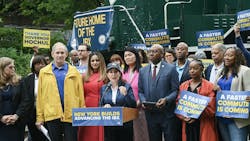MTA selects Jacobs and HDR to oversee design, engineering phase of Interborough Express project
The Metropolitan Transportation Authority (MTA) has selected Jacobs and HDR to oversee the design and engineering phase of the Interborough Express (IBX). The IBX will connect historically underserved communities in Brooklyn and Queens, N.Y., to the subway, bus and Long Island Rail Road (LIRR) while significantly reducing travel times between Brooklyn and Queens, with an end-to-end run time of 32 minutes along the 14-mile line.
In April, New York Gov. Kathy Hochul approved $2.75 billion in funding for the project as part of the 2025-2029 MTA Capital Plan.
“Building the Interborough Express will transform New York, connecting communities like never before, shortening commutes and unleashing the full potential of Brooklyn and Queens,” Hochul said. “The IBX is the sort of project that future generations will describe as a no-brainer and thanks to funding we secured for the MTA's Capital Plan, we’re not just talking about it—we’re getting it done.”
The IBX will be a new transit option for close to 900,000 residents living in neighborhoods along the route, along with 260,000 people who work near the corridor in Brooklyn and Queens. It will create 19 stations and connect with 17 different subway lines and trains, 50 bus routes and two LIRR stations. The project will be built along an existing, 14-mile freight line owned by the MTA LIRR and CSX Corp. that extends from Sunset Park, Brooklyn, to Jackson Heights, Queens. MTA notes the state of New York and Atlantic Railway currently operates freight rail on the corridor under a concession agreement on the LIRR branch.
The IBX will be the first new end-to-end rapid transit built entirely within New York City since the IND Crosstown Line, now called the G, fully opened in 1937. IBX stations built in Brooklyn will be the first transit stations built in the city’s most populous borough since the A Line extended from Broadway Junction to Euclid Avenue in 1948. IBX stations in Queens will be the first new transit stations built since the Archer Avenue extension of the E, J and Z lines to Jamaica in 1988.
“The IBX is a life-changer for millions,” said MTA Chair and CEO Janno Lieber. “It’s about time Brooklyn and Queens residents could move directly between our two most populous boroughs—for jobs, education, recreation and everything else. I want to thank Gov. Hochul and our partners in Albany and Washington for their support getting this project off the ground.”
MTA Construction & Development President Jamie Torres-Springer said, “The Interborough Express will transform mobility in New York’s two largest boroughs with fast, reliable, frequent public transit. I look forward to getting the design process underway and continuing the MTA’s track record of completing projects better, faster and cheaper than ever before.”
Design progress
Project design will officially kick off this summer, focusing on the light-rail system design including:
- Communications and signal design
- Vehicle design
- Track design, plus civil engineering efforts such as station design, bridge reconstruction and retaining wall design
- Design of the operations facility and storage yard
MTA notes the design process is the last major step in the project before formal construction begins. The project has undergone further refinement to ensure that it will provide the best service for passengers for the best value. In Middle Village, Queens, the MTA is progressing with the design of a tunnel solution beneath Metropolitan Avenue, rather than on-street operations, which the authority says will make the proposed line less prone to travel delays due to mixed traffic operations.
According to MTA, this refinement has reduced projected running times of the new line from 39 minutes to 32 minutes and has increased ridership projections to 160,000 per day, up 50,000 from the MTA's prior estimate. IBX’s projected annual ridership is higher than the current ridership of any other light-rail system in the country at 48 million riders—the next largest is Los Angeles at 46 million riders per year.
The authority notes light rail was determined to offer the best service to riders at the best value to the MTA, with about 70 percent of projected IBX riders transferring within the MTA system. Station locations were selected based on public feedback, ridership projections, ability for riders to transfer to other parts of the MTA network, constructability and spacing.
Funding
The project design phase will be principally funded through $45 million secured by Hochul in New York State’s 2025 budget and the MTA’s 2025-2029 Capital Plan. An additional $15 million was awarded to the MTA by the U.S. Department of Transportation (USDOT)’s Rebuilding American Infrastructure with Sustainability and Equity grant, which will fund a corridor assessment in support of the design phase. USDOT has also provided $1 million to fund innovative finance expert services for the project. The total estimated cost of the IBX project is $5.5 billion, with 50 percent of the total funding for the project secured in the capital plan.
